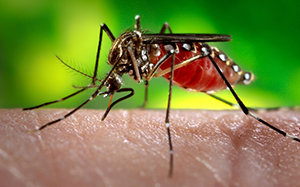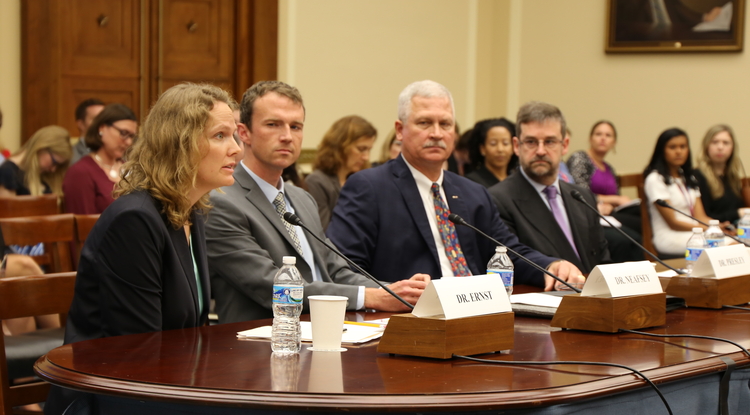Dr. Kacey Ernst testifies before a U.S. House subcommittee, saying that a recent study expects the Aedes aegypti mosquito to increase in numbers across the South and East.
With concern growing over a potential epidemic related to the Zika virus, a team of scientists with collaborators from the University of Arizona has defined higher risk areas in the United States. The team was led by National Center for Atmospheric Research scientist, Andrew Monaghan, PhD.
Researcher Kacey Ernst, PhD, MPH, associate professor and infectious disease epidemiologist at the UA Mel and Enid Zuckerman College of Public Health, said the factors included in the assessment of the 50 jurisdictions were:
1) The relative modeled abundance of Ae. aegypti;
2) Travel from areas where Zika is currently transmitted; and
3) Poverty as an indicator of vector-human contact.
 The Aedes aegypti mosquito, which is spreading the Zika virus in Latin America and the Caribbean, is expected to increase across much of the southern and eastern United States as the weather warms, according to a recent study led by mosquito and disease experts at the National Center for Atmospheric Research (NCAR) and the UA.
The Aedes aegypti mosquito, which is spreading the Zika virus in Latin America and the Caribbean, is expected to increase across much of the southern and eastern United States as the weather warms, according to a recent study led by mosquito and disease experts at the National Center for Atmospheric Research (NCAR) and the UA.
See Figure 4 (page 14) for the best estimate of potential range of mosquitos that could transmit the Zika virus, according to the study. This does not mean that all areas will be affected, nor does it mean all other areas are guaranteed safe. Mosquito monitoring and surveillance in the U.S. is not consistent across jurisdictions, said Dr. Ernst.
The study results are a step toward providing information to the broader scientific and public health communities on the highest risk areas for Zika emergence in the United States, she said, but more research is needed to determine the role of Ae. Albopictus, which is also capable of transmitting Zika virus and has a broader geographic range but does not feed on humans as much as Ae. aegypti. Other gaps include the extrinsic incubation period of Zika virus and whether there is vertical transmission from infected Ae. aegypti females to their offspring, which might mean the virus could survive in eggs that would hatch the following year.
Dr. Ernst spoke before the U.S. House of Representatives Committee on Science, Space, and Technology, Subcommittee on Research and Technology, in Washington, D.C., on May 25.
Video and transcript of her testimony can be viewed at: https://science.house.gov/legislation/hearings/full-committee-hearing-science-zika-dna-epidemic
Mosquito experts recommend removing standing water to help eliminate breeding grounds in addition to the following guidelines offered by the Centers for Disease Control and Prevention: wear insect repellant, cover up and screen windows and doors to keep mosquitoes from entering.
MEDICAL WRITERS/ASSIGNMENT EDITORS NOTE:
A transcript of Dr. Ernst’s testimony before the U.S. House of Representatives Committee on Science, Space, and Technology is available at https://science.house.gov/sites/republicans.science.house.gov/files/documents/HHRG-114-SY-WState-KErnst-20160525.pdf
All committee advisories and news releases are available at https://science.house.gov/news
The University of Arizona has created a Web page to assist members of the media in their coverage of the Zika virus. Images, video and more can be found at https://uanews.arizona.edu/zika
About the University of Arizona Health Sciences
The University of Arizona Health Sciences is the statewide leader in biomedical research and health professions training. The UA Health Sciences includes the UA Colleges of Medicine (Phoenix and Tucson), Nursing, Pharmacy and Mel and Enid Zuckerman College of Public Health, with main campus locations in Tucson and the growing Phoenix Biomedical Campus in downtown Phoenix. From these vantage points, the UA Health Sciences reaches across the state of Arizona and the greater Southwest to provide cutting-edge health education, research, patient care and community outreach services. A major economic engine, the UA Health Sciences employs almost 5,000 people, has nearly 1,000 faculty members and garners more than $126 million in research grants and contracts annually. For more information: http://uahs.arizona.edu
ALSO SEE:
"UA Researcher Kacey Ernst Maps Potential Risk Areas for Zika" (UANews) | Posted May 26, 2016
Media Contact: Rebecca Ruiz McGill


